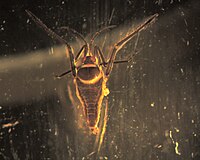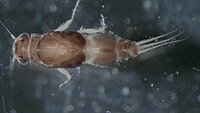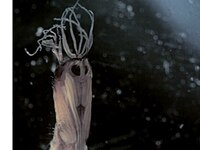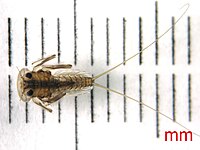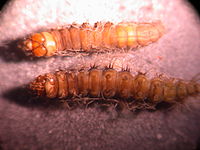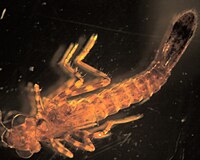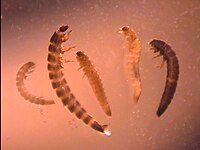Riveras Stream
From WikiEducator
| Stream code: | PN_RivStrm_154 |
| Basin: | Puerto Nuevo |
| State or Province: | Puerto Rico |
| Country: | USA |
| Latitude: | 18.3547 |
| Longitude: | -66.055456 |
| School: | University Gardens High School |
The following are the most common invertebrates collected from this stream site.
Contents
Veliidae
This family of Hempitera actually lives on the surface of the water, but can sometimes float into the net while taking benthic samples. Members of the family Veliidae are characterized by the claw of the foreleg; it is inserted before the apex. Also, its hind leg has a beautiful fan of hydrofuge hairs.
Click here to see the claw inserted before the apex and the fan of hydrofuge hairs.
Caenidae
These "small square-gill" mayflies have operculate (plate-like) gills on segment 2 that cover gills on segments 3 to 6. Their bodies are built for crawling, and their heads are held vertically. The genus Caenis is commonly found.
More information on Caenis.
Diptera
Pupae from the order Diptera are typically found in small numbers at every site. These can be identified further, but we do not.
Chironomidae
Midge larvae tend to be the most common macroinvertebrate at our sites. As with other Diptera, there are no true jointed legs. Chironomidae do have a pair of prolegs at each end and preserved individuals tend to curl into a 'C'. Identification past family requires slide-mounted heads. We have seen philopotamid caddisflies misidentified with the chironomids and we suspect that that happens when samples are being sorted from trays. Under a microscope, six prominent legs can be seen on members of the caddisfly family Philopotamidae.
More information on Philopotamidae.
Heptageniidae
- Order
- Ephemeroptera
- Family
- Heptageniidae
- Common name
- flatheaded mayfly
- Tied fly
- Light Cahill, Wingless Pale Evening Dun
This family of mayflies can be characterized by their distinctly flattened heads and striking resemblance of the character 'Jack Skellington' from the movie 'The Nightmare Before Christmas.' This family can either have two or three cerci (tails).
Commonly encountered genera include:
Pyralidae
Larvae in this lepidopteran family do not necessarily have body filaments though this one does. It has welts on the bottom of its abdomen, and three pairs of stubby- but still segmented- legs on the thorax.
Coenagrionidae
- Order
- Odonata
- Family
- Coenagrionidae
- Common name
- narrowwinged damselflies
- Tied fly
- Polly's Green Damsel
These damselfly larvae (sub-order Zygoptera) can be distinguished from dragonfly larvae (sub-order Anisoptera) by their more slender bodies and the presence of three leaf-like gills at the end of the abdomen and The family Coenagrionidae is characterized by its distinctly shaped labium which may or may not be extended.
Images of the gills at the end of abdomen, and another here. An image of the labium, and an extended labium.
Elmidae
We very commonly find adult and larval riffle beetles. The adults are clearly beetles, but the larvae can be confused with other orders. The forward pointing tooth on the front end of the larvae as described in the key can be a challenge to see, particularly in small individuals. Larvae are characterized by having a single tarsal claw at the end of their legs, which have 4 segments. Adults, on the other hand, have two tarsal claws at the end of each leg. Commonly encountered genera include Dubiraphia, Macroychu, Optioservus, Phanocerus, Promoresia, and Stenelmis.
Images of the adult and larval riffle beetles.
More information on Dubiraphia, Macronychus, Optioservus, Phanocerus, Promoresia, and Stenelmis.

